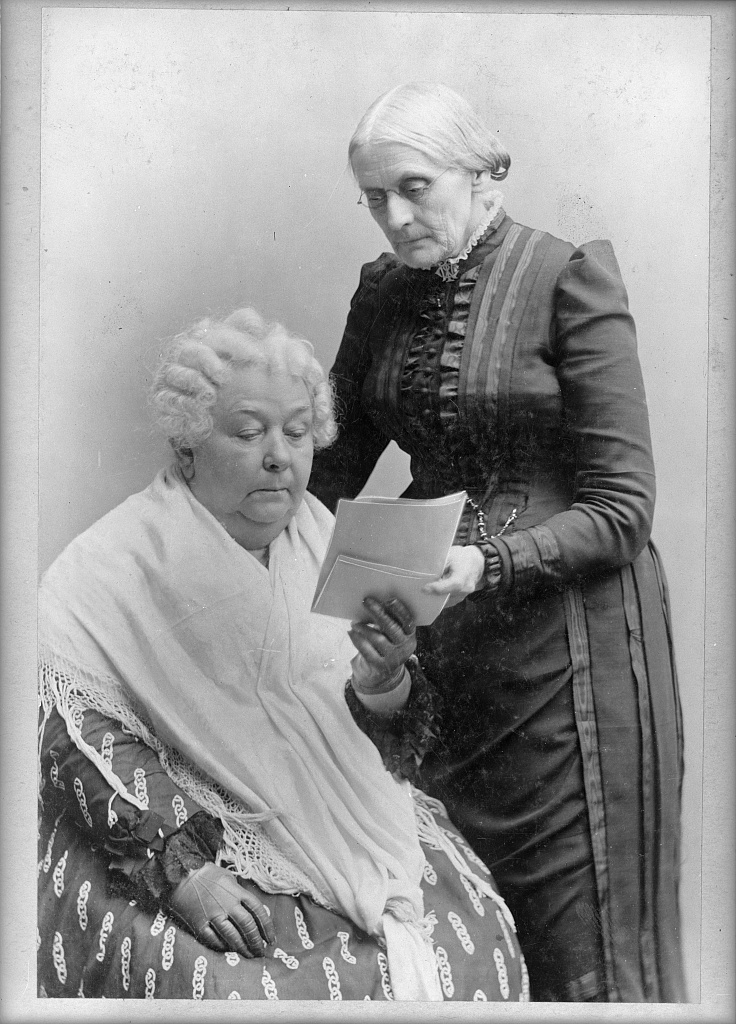Published: March 25, 2019
“It is fifty-one years since we first met, and we have been busy through every one of them, stirring up the world to recognize the rights of women."
Anthony was born in 1820 near Adams, Massachusetts to a family of Quakers. At an early age, she was already aware of injustices witnessing her father’s refusal to purchase cotton from slave labor. As a teacher, she noticed that she was paid a fraction of her male counterparts. "Anthony’s experience with the teacher’s union, temperance and antislavery reforms, and Quaker upbringing, laid fertile ground for a career in women’s rights reform to grow." (NPS)
Anthony became lifelong friends with Elizabeth Cady Stanton, another staunch women’s rights activist. In 1848, Canton presented the Declaration of Rights and Sentiments at the Seneca Falls Convention which took place in upstate New York. This convention kicked off the women’s rights movement. Several activists were present including social reformer Lucretia Mott and Frederick Douglass escaped slave and abolitionist.
During the Civil War and the years that lead up to it, there was some strife as the suffragists were told to put their crusade aside since enslaved individuals were worse off than privileged white women. Anthony conceded that point, but reminded everyone that half the slaves were also women. This sentiment was echoed by former slave and women’s rights activist Sojourner Truth. Anthony helped fugitive slaves escape and held an anti-slavery rally. She and Stanton gathered signatures to pass the 13th Amendment to the U.S. Constitution formally abolishing slavery. In 1870, the passage of the 15th Amendment of the U.S. Constitution caused additional rifts because it eliminated voting restrictions due to race or color, but not gender.
Despite the setback, Anthony and Stanton continued to speak out for women’s rights. Anthony "envisioned a Nation where women helped make the laws and elect the lawmakers. She envisioned a Nation that protected the rights and privileges of all Americans, regardless of skin color, sex, or any other physical characteristics." (whitehouse.gov) Anthony lived in Washington, DC, meeting regularly with Congressmen and traveling around the country giving talks. Some of the states and U.S. territories were already giving women more rights including voting, property rights, running for office, and serving on juries.

With other activists, Stanton and Anthony formed the National Woman Suffrage Association. In November 1872, Anthony and other women registered as voters. Ironically, she expected to be denied registration as this had been the case for most other women who tried. On November 5, she cast her ballot and there was no uproar. A few weeks later, she was arrested. At her trial in Canandaigua, New York on June 17, 1873, Anthony was found guilty by a jury of twelve men and fined $100. She challenged the judge to hold her in custody until she paid the fine; he never did knowing this would enable her to take her case to the Supreme Court. Anthony never paid the fine. (NPS)
Susan B. Anthony saw several improvements to the lives of women: more women were going to college, controlling their own property, getting better job opportunities, and leaving abusive husbands. After her death in 1906 in Rochester, New York, the suffragists’ momentum continued. Once New York State gave women the right to vote in 1917, President Woodrow Wilson supported a constitutional amendment. In 1920, the 19th Amendment to the U.S. Constitution: Women’s Right to Vote passed the House and Senate. The 19th Amendment became known as the Susan B. Anthony Amendment.
Sources: National Park Service, Library of Congress, National Archives, The White House
Related Publications
Honoring Susan B. Anthony - 151 Cong. Rec. 2880
Remarks by Congress member Ileana Ros-Lehtinen on February 17, 2005.
Susan B. Anthony Dollar Coin Act - 92 Stat. 1072
Public Law 95-447 was approved October 10, 1978.
Statute Compilation of Voting Rights Act of 1965 (What's a Statute Compilation?)
Joint resolution expressing the sense of Congress with respect to the women suffragists who fought for and won the right of women to vote in the United States - 119 Stat. 457
Public Law 109-49 was approved August 2, 2005.
Constitution of the United States of America: Analysis and Interpretation
The Constitution of the United States of America: Analysis and Interpretation, popularly known as the Constitution Annotated, encompasses the U.S. Constitution and analysis and interpretation of the U.S. Constitution with in-text annotations of cases decided by the Supreme Court of the United States.
The following are from the Constitution Annotated Centennial Edition Interim Edition: Analysis of Cases Decided by the Supreme Court of the United States to August 26, 2017, S. Doc. 112-9.
Thirteenth Amendment - Slavery and Involuntary Servitude
Fifteenth Amendment - Rights of Citizens to Vote
Nineteenth Amendment - Women's Suffrage Rights
Additional Resources
- Presidential Message on Susan B. Anthony Day, 2019 (The White House)
- The 19th Amendment (National Archives)
- Susan B. Anthony Collection (Library of Congress)
- Susan B. Anthony the Struggle for Suffrage (National Archives)
- LOC Collecion: Susan B. Anthony Papers
- Portrait Monument to Lucretia Mott, Elizabeth Cady Stanton, and Susan. B. Anthony (Architect of the Capitol)
- Plan your visit to Susan B. Anthony’s birthplace (National Park Service)
- Old Friends Elizabeth Cady Stanton and Susan B. Anthony made History Together (Architect of the Capitol)
- Elizabeth Cady Stanton Papers (Library of Congress)
- Read and learn about the case, U.S. vs. Susan B. Anthony: The Fight for Women’s Suffrage, and check out the teaching resources. (Federal Judicial Center)
- U.S. Census Bureau History: Women's Suffrage